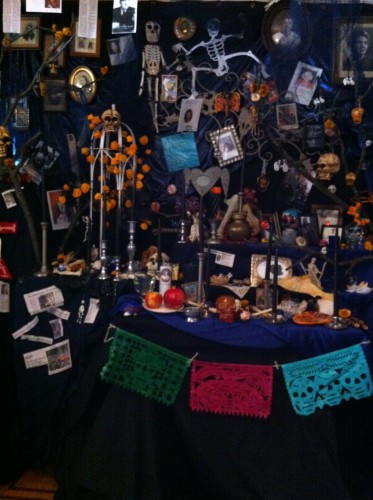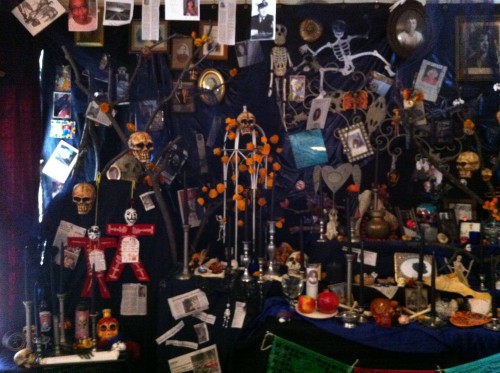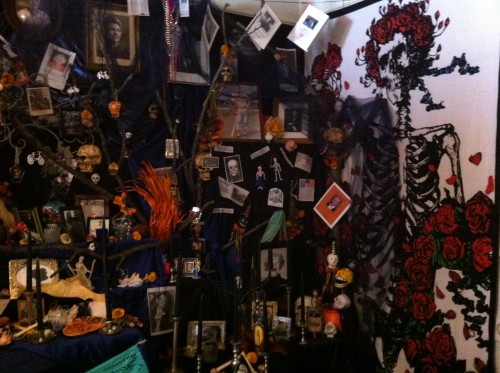 There are so many different ways to celebrate during this time of year, and the plethora of Pagan celebrations go throughout the month of October and through the first week of November. While a large majority of Pagan practices happen on October 31st or November 1st, the actual astrological day for Samhain this year is November 7th, lending for more time to have more celebrations. Festivals of ancestral honor continue in many different traditions and cultures; two of the most known, of course, include Dias De Los Muertos ending November 2nd, and All Saints Day on November 1st.
There are so many different ways to celebrate during this time of year, and the plethora of Pagan celebrations go throughout the month of October and through the first week of November. While a large majority of Pagan practices happen on October 31st or November 1st, the actual astrological day for Samhain this year is November 7th, lending for more time to have more celebrations. Festivals of ancestral honor continue in many different traditions and cultures; two of the most known, of course, include Dias De Los Muertos ending November 2nd, and All Saints Day on November 1st.
After writing my ancestral piece last month, we were contacted by a priestess in the Bay Area about her coven’s practices and process of ancestral worship. I took the opportunity to correspond with Cynthia of Circle of Winged Toads, a coven that is a descendant from the Compost Coven started in the 70’s, because I was very moved by the pictures of their elaborate ancestor altar.
Different practices dictate different processes, and the length of time needed for the preparation of any rite; practices at this time of year can take a matter of days or weeks to get ready for. This is one of the covens that take a lot of time in preparation to put up their ancestor altar every year. I found the pictures of the altar that were sent to the Wild Hunt fantastic and quite fascinating. Cynthia answered a few questions for me about the altar and ancestral practice during this time of year.
 What do you find to be important about this time of year?
What do you find to be important about this time of year?
I feel connecting with ancestral spirits and my own mortality is important at this time of year. I also want to honor those in the community who have passed. This year I noticed that where as I used to have several people each year who had died from AIDs now it is bicyclists here in San Francisco. So I hung white ghost bikes on the altar.
How long have you been building this ancestral altar?
I have been doing this for around 25 years. It started pretty simple using the buffet in my dining room. As I continued to host our covens ritual each year people would leave things behind. So when I take the altar down I save photos and drawings for the next year. Thanks goddess I have an attic.
When do you put it up and take it down, and how long does it take?
I put it up over 2-3 days in early to mid October. Then fine turn as I meditate with the spirits each evening. I leave it up until early November so I can appreciate the transformation after the covens ritual on Samhain night.
What types of things do you look for in a well-crafted altar and how do you gauge what should go on it?
It’s all about the spirit. Items that belonged to my grandmother always have pride of place. I am fortunate to live in San Francisco within walking distance of the Mission district where I can find many Dia De Los Muertos items that are beautifully made. I like a touch of whimsey too.
 Inspiration, creativity, and ideas can be ignited by the sharing of some of the incredible practices of other Pagans. I hope you enjoy the pictures of this incredible and detailed altar as much as I did.
Inspiration, creativity, and ideas can be ignited by the sharing of some of the incredible practices of other Pagans. I hope you enjoy the pictures of this incredible and detailed altar as much as I did.
As the ancestral celebrations this time of year come to a close, I wish everyone a season of love, health, wisdom and guidance. May those who have gone before inspire and inform us on our journeys.
The Wild Hunt is not responsible for links to external content.
To join a conversation on this post:
Visit our The Wild Hunt subreddit! Point your favorite browser to https://www.reddit.com/r/The_Wild_Hunt_News/, then click “JOIN”. Make sure to click the bell, too, to be notified of new articles posted to our subreddit.
Very nice! Thank you for detailing this, Crystal, and Cynthia for doing this!
Just a note: the notion of “astrological Samhain” is not remotely traditional, it’s an innovation by modern Wiccans and has nothing to do with the actual and ongoing practice of Samhain in Ireland. The month of November is Samhain in Modern Irish, and it has been marked and called such since the very early medieval period, and because the day starts with the sundown the night before, October 31st’s sundown is and always has been Samhain. There is evidence for the “Thirds of Samhain” being celebrated in Ireland: namely, three days before, three days after, and the day of Samhain itself, as noted in Serglige Con Culainn; but, anything past November 3rd/4th is no longer in the picture, except insofar as it falls within the month known as Samhain.
If people do wish to celebrate “astrological Samhain,” that’s fine, but the way in which many people who do celebrate on that date speak of it as “actual Samain” and somewhat turn their noses up at those who celebrate on Oct. 31 or Nov. 1 is not only rude, it’s also entirely non-traditional and not in line with ancestral practices that are any older than the 1960s. New traditions are certainly fine, but where they contravene far older traditions and yet are treated by those who uphold them as if they’re “the right/best way,” and are claimed to be possessed of a “realness” within the tradition which they simply do not, there is a certain amount of dishonesty and cultural appropriation involved which cannot be excused. Thank you, Crystal, for not being “one of those people”! 😉
Fantastic information. And yes, I have heard of some people claiming what is “real” and what is not when it comes to dates and Samhain. I use the term astrological samhain because that is how I have repeatedly seen it referred to, but not because I have a personal take in that. (glad you noticed that).
I think there is so much richness in this time of year and the many different practices, and I wish we could celebrate the uniqueness of differences instead of right or wrong.
Maybe one day….. 🙂
Indeed, that would be wonderful!
Though, as you also said above, if astro-Samhain (that kind of has a fun ring to it…!?!) kind of adds to and extends the holy season a bit more, then it’s all the better. The Sacred Nights of Antinous, which run from the 24th of October to the 1st of November, feels like a rather long period (it’s nine days), but at the same time, there was barely enough time within that to do everything that was important and that needed time and attention spiritually. So, if the period extended even further, for those who are able and interested, why not? 😉
It might be worth clarifying here what the “astrological Samhain” is. The astronomical midpoint between solstice and equinox, or equinox and solstice falls a few days later than the traditional dates of the “cross-quarter” sabbats.
This midpoint *always* falls at 15 degrees of the fixed signs — Scorpio (Samhain), Aquarius (Imbolc) Taurus (Beltane), and Leo (Lughnasad). Astrologically, 15 degrees of fixed signs, like zero degrees of cardinal signs (the solstices and equinoxes) are traditionally known as deeply powerful points in the zodiac. So celebrating the cross-quarters at the actual moment of the crossing of the quarter may not be traditional Irish folk practice, but it is astronomically correct and certainly makes sense if your spiritual practice is informed by astrology.
Personally, I like week-long holidays, and generally stretch my celebrations over a week so that I can include both the traditional and the powerful astronomical dates.
Though it’s also important to remember that in actual Irish and Scottish practice and folklore, Samhain, Imbolc, and the rest are not “cross-quarters,” they’re considered quarter days. Solstices and equinoxes were not as important in the historically-recorded and reliable periods of these cultures (and are often not even marked on some ancient stone cirlces in Britain and Ireland, though Samain/Imbolc and Lugnasad/Beltaine are, or sometimes only Samain/Imbolc, which is the same marker invariably!)…
It depends entirely on where one’s emphasis is, certainly. For those who are interested in traditional cultures, it’s obvious that astrology won’t often have as high a regard as traditional folk practice.
Yes, absolutely. If you are going the traditional or reconstructionist route, that ain’t no cross quarter, that’s a seasonal marker! 🙂 All depends on your approach.
Oh, and this is a lovely article, Crystal and Cynthia. Thank you. 🙂